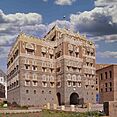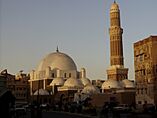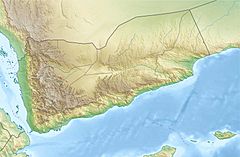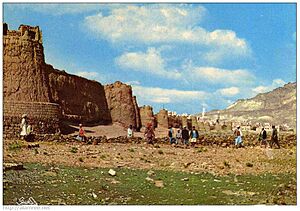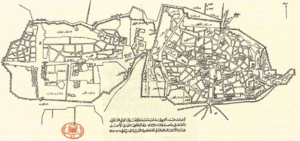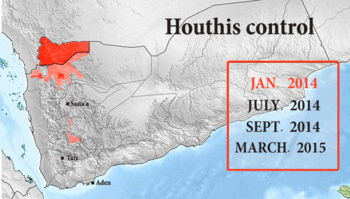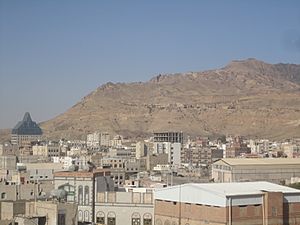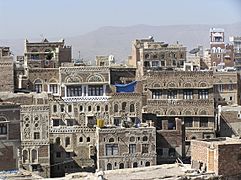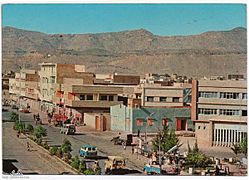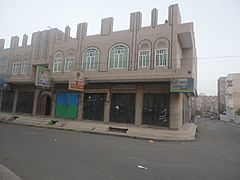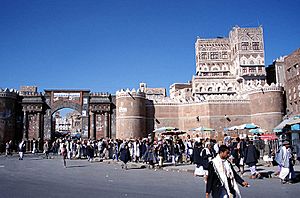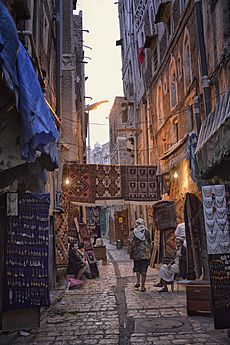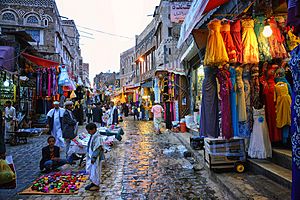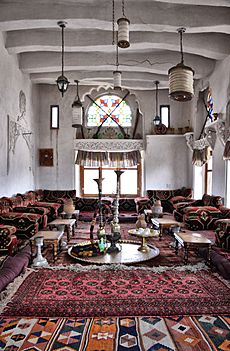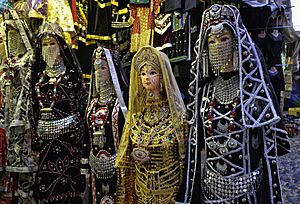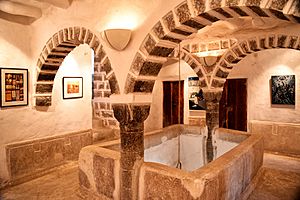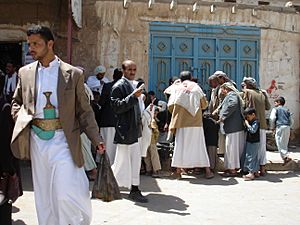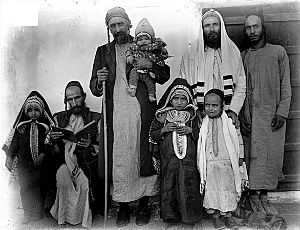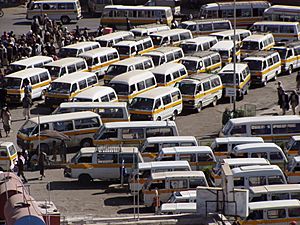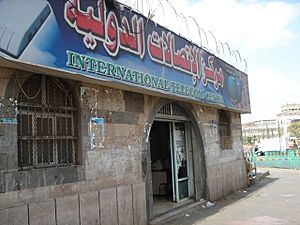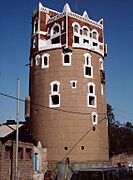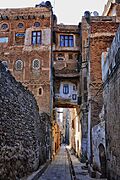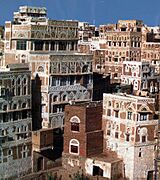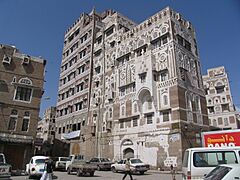Sanaa facts for kids
Quick facts for kids
Sanaa
صَنْعَاء
|
|
|---|---|
|
The skyline of the Old City of Sanaa
Houses in the old city
Al-Saleh Mosque
Rainy day in Sanaa
Gate of Yemen
National Museum of Yemen
Al-Bakiriyya Mosque
|
|
| Nickname(s):
ʾAmānat Al-ʿĀṣimah (أَمَانَة ٱلْعَاصِمَة)
|
|
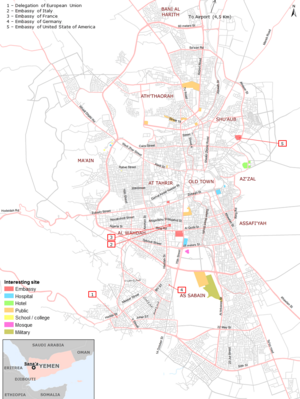
Map of the city
|
|
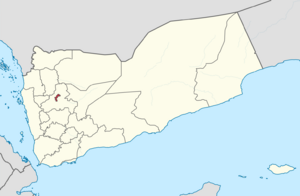
Sanaa in the Republic of Yemen
|
|
| Country | |
| Governorate | Independent city |
| Control | |
| Area | |
| • Total | 126 km2 (49 sq mi) |
| Elevation | 2,250 m (7,380 ft) |
| Population
(2017)
|
|
| • Total | 2,545,000 |
| • Estimate
({{{pop_est_as_of}}})
|
3,407,814 |
| • Density | 20,320/km2 (52,600/sq mi) |
| Demonym(s) | Sanaani, San'ani |
| Time zone | UTC+3 (AST) |
Sanaa (pronounced San-ah), also known as the Sanaa Municipality, is the capital and largest city in Yemen. It's a special administrative area, not part of the surrounding Sanaa Governorate. Even though it's the official capital, the Yemeni government moved its base to Aden in 2015 due to ongoing conflict.
Sanaa is one of the highest capital cities in the world. It sits at an elevation of about 2,300 meters (7,500 feet). The city is near the Sarawat Mountains, which include Jabal An-Nabi Shu'ayb, the tallest mountain in the Arabian Peninsula. Sanaa is home to about 3.3 million people (as of 2023). This makes it Yemen's biggest city. About 10% of Yemen's total population lives in the greater Sanaa area.
The Old City of Sanaa is a UNESCO World Heritage Site. It's famous for its unique buildings, especially its tall, multi-story houses with cool geometric designs. The Al Saleh Mosque, the largest mosque in Yemen, is on the city's southern edge. Sadly, some historic sites in the Old City were damaged during conflicts in 2015.
Sanaa is currently facing a big water shortage. Water is being used much faster than it can be replaced. Experts predict the city might run out of water by 2030. This would make it the first capital city in the world to face such a crisis. Clean drinking water is hard to find, and its quality can be a problem.
Contents
History of Sanaa
Ancient Times
Some old Islamic stories say that Sanaa was built by Shem, the son of Noah. He supposedly founded the city at the base of Jabal Nuqum mountain.
The name Sanaa likely comes from an old word meaning "well-fortified." This name appears in ancient writings from the 3rd century CE. A popular story today says the name means "excellent trades and crafts."
A historian from the 10th century, al-Hamdani, wrote that Sanaa's old name was Azāl. This name is linked to Uzal, a person mentioned in the Bible.
Al-Hamdani also wrote that the Sabaeans built walls around Sanaa. Their ruler, Sha'r Awtar, might have also built the Ghumdan Palace there. Because of its location, Sanaa was a busy center for trade in southern Arabia. It was at a crossroads of two important ancient trade routes.
Sanaa was also an important military base for the Sabaeans. They used it for their trips against the kingdom of Himyar. Old writings mention them returning to Sanaa after winning battles. The Ghumdan Palace is also mentioned in these writings.
Later, when King Yousef Athar ruled, Sanaa was the capital for the Axumite leaders. It's also believed that the Abyssinian leader Abrahah built a Christian church in Sanaa.
Islamic Era
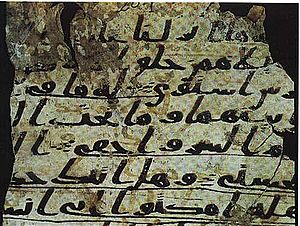
From the time of Muhammad (around 622 CE), Sanaa was a key governing city. Many Yemeni states wanted to control it.
Al-Shafi'i, a famous Islamic scholar from the 8th century, visited Sanaa many times. He loved the city and said, "Sanaa must be seen." In the 9th and 10th centuries, people wrote about how clean and pleasant the city was. A Persian geographer, Ibn Rustah, called it the greatest and most prosperous city in Yemen.
In 1062, the Sulayhid dynasty took over Sanaa. Their leader, Ali al-Sulayhi, made it the capital of his small kingdom. His wife, Queen Asma, was also very important. After Ali al-Sulayhi was killed, his daughter, Arwa al-Sulayhi, moved the capital to Jibla. Then, the Hamdanid dynasty took control of Sanaa.
In 1173, Saladin, the ruler of Egypt, sent his brother to conquer Yemen. The Ayyubids took control of Sanaa in 1175. They united many Yemeni tribes. The Ayyubids changed the country's official religion to Sunni Muslim. During this time, the city improved a lot. However, the Ayyubids often chose Ta'izz as their main capital.
Later, the Zaydi imams mostly ruled Sanaa from 1323 to 1454. The Mamelukes arrived in Yemen in 1517.
Ottoman Rule
The Ottoman Empire took over Sanaa in 1547. European traders often visited Sanaa from Yemeni port towns. In 1602, local Zaydi imams, led by Imam al-Mu'ayyad, took back control. They forced the Ottoman troops out in 1629.
The Zaydi imams ruled Sanaa until the mid-1800s. Then, the Ottomans tried to control the area again. They finally captured Sanaa in 1872. The Ottomans brought new city planning, roads, schools, and hospitals to Sanaa. These changes were meant to strengthen their control and compete with other empires. However, the improvements were still limited.
North Yemen Period
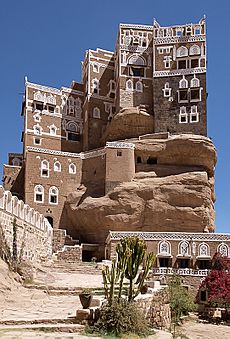
In 1904, Imam Yahya became the ruler in Sanaa. He wanted to make North Yemen independent. He tried to keep the country isolated from world politics. He also stopped new ideas and closed a girls' school. Because of this, Sanaa became a center for people who wanted change.
In the 1930s, groups formed in Sanaa to ask for reforms. But by 1936, many leaders of these groups were put in prison. In 1941, another group called for a "renaissance" and a parliament. Imam Yahya stopped them, and many leaders were executed after his son Imam Ahmad took power in 1948. That year, Sanaa was replaced by Ta'izz as the capital. Most of the city's Jewish population moved to Israel a few years later.
Imam Ahmad started some slow changes. But by 1961, people in Sanaa were protesting for faster reforms. In September 1962, military officers who supported a republic took over. This happened a week after Ahmad's death. Sanaa became the capital again.
A civil war followed, lasting until 1968. Parts of the city's old heritage were damaged. After the war, a new government was set up. Sanaa began to grow. New areas were built, and the city expanded. Many Yemenis working in other Arab countries sent money home, which helped the city's growth.
New buildings were made of concrete and had modern designs. Many families moved from the old city to these new areas. The old city faced problems like unpaved streets and poor water systems. In the late 1970s, new water pipes caused too much water to build up, damaging many old houses.
Sanaa in the 21st Century
After Yemen became one country, Sanaa was named the capital of the new Republic of Yemen. It holds the presidential palace, parliament, and government offices. Many people in Sanaa work for the government. The city has grown a lot due to people moving from rural areas. This has put a strain on the city's services, especially water.
Sanaa was chosen as the 2004 Arab Cultural Capital. In 2008, the large Al Saleh Mosque was finished. It can hold over 40,000 people.
In 2011, Sanaa was the center of the Yemeni Revolution. This led to President Ali Abdullah Saleh being removed from power. The city saw fighting between May and November 2011.
Recent Years (2014–Present)
On September 21, 2014, the Houthis took control of Sanaa.
In June 2015, airstrikes damaged historic houses in the capital. A UNESCO World Heritage Site was badly hurt.
In October 2016, airstrikes hit a funeral hall in Sanaa. Many people were killed and injured. Later, it was admitted that this attack was a mistake.
In May 2017, a cholera outbreak caused many deaths and illnesses. In late 2017, more fighting happened in Sanaa, and former President Saleh was killed.
In May 2022, the first commercial flight in six years took off from Sanaa International Airport. This was part of a peace agreement.
Geography and Climate
Natural Setting
Sanaa is on a plain called Haql Sanaa, which is over 2,200 meters (7,200 feet) above sea level. The plain is about 50–60 km (30–37 miles) long. Mountains and cliffs border it to the east and west.
Sanaa itself is in the narrowest part of the plain. It's nestled between Jabal Nuqum to the east and the foothills of Jabal An-Nabi Shu'ayb to the west. Jabal An-Nabi Shu'ayb is Yemen's tallest mountain. Because of these mountains, Sanaa has mostly grown north and south.
Jabal Nuqum rises about 500 meters (1,600 feet) above Sanaa. An old writer, Al-Hamdani, said there was an iron mine there. A dam was built at Nuqum to stop floods from damaging the city.
Some parts of the Sanaa plain show signs of old volcanic activity. There are volcanic cones and lava fields.
Architecture
Sanaa's Old City is famous for its unique tower houses. These houses are usually built from stone and brick. They can be up to 8 stories tall. Their doors and windows have beautiful plaster decorations. Traditionally, a single large family lived in one house. New floors were added as sons got married and had children.
The ground floor was often used for storing grain or housing animals. Today, many owners use the ground floor for shops. The top floor, called the mafraj, is a special sitting room. People use it for afternoon gatherings.
New tower houses are still being built in Sanaa. They often use modern materials like concrete blocks. These "neo-traditional" houses are found in both old and new parts of the city.
Most new homes in Sanaa use modern styles. "New villas" are common, which are low houses with fenced yards. Smaller, "Egyptian-style" houses are also popular.
Cityscape
Sanaa is generally split into two parts: the Old City ("al-Qadeemah") and the new city ("al-Jadid"). The Old City is smaller and keeps its ancient look. The new city is much larger, with many modern buildings and suburbs. The new parts grew quickly after Sanaa became the capital in the 1960s.
Sanaa has grown into a city with many different centers. Various areas and suburbs are now hubs for shopping, industry, and social life. This growth has often happened without central planning. Rising land prices in the city center have pushed people and businesses outwards. Markets (souks) have been very important in developing these new areas.
Neighborhoods
Old City
The Old City of Sanaa is a UNESCO World Heritage Site. People have lived in this old, fortified city for over 2,500 years. It has many well-preserved old buildings. The oldest standing building is Ghumdan Palace. The United Nations named it a World Heritage Site in 1986. Efforts are being made to protect its ancient buildings. Some, like the Great Mosque of Sanaʽa, are over 1,400 years old.
The Old City is surrounded by ancient clay walls, 9 to 14 meters (30 to 46 feet) high. Inside, there are over 100 mosques, 12 bathhouses (hammams), and 6,500 houses. Many houses look like ancient skyscrapers, reaching several stories high. They have flat roofs and are decorated with detailed carvings and stained-glass windows.
One popular spot is Suq al-Milh (Salt Market). Here, you can buy salt, bread, spices, and many other goods. The 7th-century Great Mosque of Sanaʽa is one of the oldest mosques in the world. The Bāb al-Yaman ("Gate of the Yemen") is an iconic entrance through the city walls. It is over 1,000 years old.
Traditionally, the Old City had different quarters (hara). Each quarter usually had a mosque, a bathhouse, and a garden. Waste from homes was used as fuel for the bathhouse. Gardens were watered with used water from the mosque.
Al-Tahrir
Al-Tahrir was planned as Sanaa's new main area in the 1960s. It is still the city's symbolic center. Today, it focuses more on being a civic and recreation area.
Bi'r al-Azab
Bi'r al-Azab is an old Ottoman and Jewish quarter west of the Old City. It was first mentioned in historical records in 1627.
This area was one of the first to see new development in the 1970s. Today, it is mostly a residential and administrative area. Embassies and government offices are located here.
Other Areas
The area between the two main ring roads is very busy. It has a high population and active markets. Major commercial roads cross these areas. Public transport is also widely available. Important districts here include al-Hasabah in the north and Shumayla in the south. Al-Hasabah used to be a separate village but became a suburb of Sanaa by the 1980s.
The southwestern area, along Haddah Road, is generally wealthy. It has better access to water and sanitation. Many people moved here from Aden after Yemen united in 1990. Since the 1990s, tall buildings have been built in this area.
Administration
In 1983, Sanaa's population grew rapidly. So, the city became its own governorate, called Amanat al-Asimah (meaning "the Capital's Secretariat"). In 2001, this governorate was divided into nine districts. A tenth district was added later that year.
The city of Sanaa now includes these districts:
- Old City District
- Al Wahdah District
- As Sabain District
- Assafi'yah District
- At Tahrir District
- Ath'thaorah District
- Az'zal District
- Bani Al Harith District
- Ma'ain District
- Shu'aub District
Climate
Sanaa has a cold desert climate. It gets about 265 mm (10 inches) of rain each year. Because it's so high up, temperatures are milder than in many other cities in the Arabian Peninsula. Temperatures stay fairly steady all year. January is the coolest month, and July is the warmest.
The city rarely gets extremely hot or cold. However, some areas around the city can get very cold in winter, sometimes dropping to -9°C (16°F). Frost often appears in early winter mornings. The sun warms the city to about 20–22°C (68–72°F) during the day. But it gets much colder at night, around 3–4°C (37–39°F).
Sanaa has many different small climates because of its location in a basin and uneven elevations. Summers are warm and can cool quickly at night, especially after rain. Most of Sanaa's rain falls from April to August. Rainfall amounts change each year. Some years get a lot of rain, while others get very little.
Culture
Music
Sanaa has a rich musical history. It is known for a style called al-Ghina al-San'ani ("the song of Sanaa"). This music dates back to the 14th century. In 2003, UNESCO recognized it as an important cultural heritage. This music is found in other parts of Yemen too, but it is most linked to Sanaa.
It is one of about five main types of Yemeni music. It is often played at social events, like wedding parties and daily gatherings of friends.
A singer usually performs with two musicians. One plays the qanbus (a Yemeni lute). The other plays the sahn nuhasi, which is a copper tray. The songs have lyrics in both classical and Yemeni Arabic. They are known for clever wordplay and strong emotions. Singers often use special vocal techniques.
In the early days of recording music in Yemen (1938-1940s), Sanaani music was very popular. As records became cheaper, more people bought them. But then, other types of music from the West, India, and other Arab countries became popular too.
Theatre
Yemen has a lively tradition of theatre that is over a century old. In Sanaa, most plays are performed at the Cultural Center. Yemeni women act alongside men on stage. They also write and direct plays. Women make up a large part of the audience, often bringing their children. This is different from other countries in the Arabian Peninsula.
Since Yemen united in the early 1990s, the government has supported yearly national theatre festivals. These usually happen around World Theatre Day on March 27. In recent years, more actors and directors have come from Sanaa. In 2012, there was a national theatre competition. Troupes from all over the country competed.
The war in Yemen has affected Sanaa's theatre scene. Since 2014, new rules have been put in place about dress and entertainment. However, in December 2020, a theatre group performed in Sanaa. They wanted to offer comfort and fun to people suffering from the conflict. Many men, women, and children came to watch.
Sports
Football is the most popular sport in Sanaa. The city has the Ali Muhesen Stadium. This is where the Yemen national football team plays. The stadium can hold 25,000 people.
Zoo
Sanaa has a zoo, like the one in Ta'izz. It used to have animals caught in the wild, like the Arabian leopard. It also had imported animals, such as African lions and gazelles. The lions were thought to be from Ethiopia. But tests showed they were more like lions from Eastern and Southern Africa.
Qat
In Sanaa, many people chew Qat every day. Qat is a plant with stimulant effects. This happens in a special room called a mafraj. Qat comes in different types, like red, white, and blue. Red Qat is considered the best quality. People buy fresh Qat leaves each day.
Demographics
| Historical population | ||
|---|---|---|
| Year | Pop. | ±% p.a. |
| 1911 | 18,000 | — |
| 1921 | 25,000 | +3.34% |
| 1931 | 25,000 | +0.00% |
| 1940 | 80,000 | +13.80% |
| 1963 | 100,000 | +0.97% |
| 1965 | 110,000 | +4.88% |
| 1975 | 134,600 | +2.04% |
| 1981 | 280,000 | +12.98% |
| 1986 | 427,505 | +8.83% |
| 1994 | 954,448 | +10.56% |
| 2001 | 1,590,624 | +7.57% |
| 2004 | 1,748,000 | +3.19% |
| 2005 | 1,937,451 | +10.84% |
| 2023 | 3,769,615 | +3.77% |
Sanaa's population grew very fast from the 1960s. Many people moved from rural areas to find jobs and a better life. Sanaa is the fastest-growing capital city in the world. Its population grows by 7% each year. About 10% of the people live in the Old City. The rest live in the newer districts.
The population in Sanaa is very young. Almost 60% of people in the Sanaa Governorate are under 18 years old. There are slightly more males than females.
Most people in Sanaa practice Zaydi Islam. Sunnis and Isma'ilis are smaller groups. Sunnis are more common in the newer parts of the city. This shows that new residents have moved in from the countryside.
Social Classes
Before the 1962 revolution, Sanaani society had clear social classes. From highest to lowest, they were: the sayyids, the qadis, the mansibs, the Bani Khumis, and the akhdam. Since then, this system has changed a lot.
The sayyids were at the top. They claimed to be descendants of Muhammad. The qadis were below them, claiming descent from judges. These groups still have a strong cultural influence today.
Below them were the manasib. These were skilled workers in "honorable" trades. This included metalworkers, carpenters, and builders. Even though these jobs were sometimes looked down upon, they were respected.
The Bani Khumis did jobs that the higher classes avoided. This included shoemakers, butchers, and barbers. The akhdam were the lowest class, mostly street sweepers.
This old class system changed quickly after the 1962 revolution. By the 1970s, wealth became more important than birthright. For example, being a merchant was once looked down upon. But as it became profitable, it gained respect. This change was much stronger in Sanaa than in rural areas. New education, Yemenis working abroad, and global trade helped this shift.
Jewish Community
Jewish people have lived in Yemen since the 5th century BCE. In Sanaa, Jews lived in different parts of the city over time. In 1679, they were forced to leave the city for a short time. When they returned in 1680, they built a new Jewish Quarter outside the city walls. They lived there until the mid-20th century.
After Israel was created in 1948, about 49,000 Yemeni Jews moved there. Almost 10,000 of them were from Sanaa. For a while, there were almost no Jews left in Sanaa. However, after conflict started in northern Yemen in 2004, the government offered refuge to Jews in Sanaa. In 2010, about 700 Jews lived in the capital under government protection.
In April 2017, it was reported that 40 of the last 50 Jews were living near the American Embassy. They faced threats from the Houthis. By July 2020, only a "handful" of Jews remained in Sanaa.
Economy
In the past, Sanaa had a mining industry. People mined for onyx and other stones in the hills around the city. Sanaa also traded farm products. It was a main market for imported goods because it was on a trade route. The city was also known for its metalwork. In the early 1900s, the British said it was "famous."
As Yemen's capital, nearly 40% of jobs in Sanaa are in the government. The city is also an important center for business and industry. Many people also work in the informal sector, which is about 32% of non-government jobs.
The largest part of the economy is in commerce and small services. In 2004, this made up almost 60% of businesses and 31% of jobs. Government administration is the second largest employer. Manufacturing is the third largest. Sanaa also has more hotels and restaurants than other parts of Yemen.
About 62% of jobs in Sanaa are in private, local businesses. State-owned businesses employ 31%. The average business in Sanaa is small, with about 3.88 employees. However, this is higher than the national average. Between 1992 and 2006, 39% of all new jobs in Yemen were created in Sanaa.
Poverty and Inequality
Even though Sanaa has a busy economy, it also has the most poverty in Yemen. About 15% of the city's people lived below the poverty line in 2007. Many more live just above it, in a risky financial situation. High unemployment is also a problem. Some estimates say 25% of Sanaa's potential workers are unemployed.
Income inequality is also growing. This means the gap between rich and poor is getting wider. High inflation and low income growth have made it harder for the middle class since the 1980s.
Challenges for Businesses
A 2005 survey found that businesses in Sanaa face many challenges. Corruption is a big problem when dealing with the government. Bribes are often needed. Some businesses use their connections to avoid taxes, which is unfair to others. Long delays for customs are common, especially for imports. Many businesses reported making extra payments to customs officials.
Money problems also affect entrepreneurs. Bank loans are very expensive. Also, city services like electricity are unreliable. Many businesses have to buy their own backup generators.
Energy
Before the recent conflict, Yemen's electricity mainly came from the Ma'rib gas power plant. This plant started in 2009. It supplied 27% to 40% of the country's electricity. Before that, Sanaa got power from six diesel plants. The power line from Ma'rib to Sanaa was often attacked. There were 54 attacks between 2010 and 2013. The Ma'rib plant stopped working in 2015.
Sanaa also has substations that can generate power. The Dhahban station is the main one. It had a capacity of 50 MW. The Hizyaz station has three power plants.
Most of Sanaa had electricity before the conflict. But access was unreliable. Power outages were common. One report in 2011 said electricity was only available for one hour a day.
The conflict has badly damaged Yemen's energy sector. Many power assets in Sanaa were destroyed or damaged. As a result, public power is almost nonexistent. The city now gets only a small amount of electricity from the Hizyaz station. Only about 2% of people get public electricity, and it's expensive. Private services with generators also sell electricity. They cover another 2.8% of the population.
The biggest source of electricity in Sanaa now comes from private solar panels and diesel generators. These cover 30% of the population. Solar power became very popular in Yemen in 2015. By 2016, it was the main source of electricity in the country.
Fuel prices in Yemen have risen sharply since the war began. In September 2019, there were long lines at gas stations. Black market prices can be three times higher than official prices. This makes fuel unaffordable for many.
Education
Distribution of education levels among Sanaa residents in 2004. Illiterate (21.9%) Read and write (32.0%) Primary (6.0%) Secondary and equivalent (15.8%) Higher education (7.4%) Vocational — basic (14.2%) Other or unspecified (2.7%)
Sanaa has a relatively well-educated population compared to other Yemeni cities. Wealthier residents often prefer Private education. However, access to private schools is not as good as in other capital cities in the region.
Each district in Sanaa has its own educational area. These areas have several government schools.
The conflict in Yemen has greatly affected education in Sanaa. After the national bank moved in 2016, public-sector employees in Houthi-controlled areas stopped getting salaries. Many teachers quit because of this. They were replaced by volunteers who were not as experienced.
Sanaa University was founded in 1970. Its goal was to train Yemenis to become teachers. In 1984, it was the only higher education institute in Yemen. Its student numbers grew from 68 in 1970 to about 9,700 in 1983–84. In its early years, Kuwait largely funded the university. Most professors and materials also came from Kuwait. By the 1980s, most professors were from Cairo. About 10% of the students were female. The university year has two 18-week semesters and an 8-week summer session. In 1984, classes were taught in Arabic, except for science, which was in English.
Transport and Communications
Transportation in Sanaa is different for men and women. Slightly more men (51%) use public transport. Slightly more women (56%) travel by walking. Using personal cars is less common than public transport for both genders. Few people use bicycles or motorcycles.
Public transport in Sanaa is mostly informal. Most vehicles are privately owned. Common vehicles include small buses (dababs) and minibuses. Taxis are also very common. Public transport is good in the city center. But the outskirts of Sanaa are not well served. People often have to walk long distances to reach main roads. Most routes are short. This means longer trips need multiple bus changes. Bus schedules can also vary, leading to long waiting times. There are also coaches to major cities like Aden and Taiz.
Sanaa has a large road network. Most money for transport has gone into roads. The city's roads mainly run north–south. There are two main ring roads. Roads are often crowded. Many taxis drive empty, adding to traffic. This also causes high air pollution. Sanaa is in a basin surrounded by mountains. This traps pollutants in the air.
Sanaa has the most traffic accidents in Yemen. In 2013, there were 2,898 accidents. This was more than double the number in Ta'izz. Factors include loose traffic law enforcement, lack of traffic signals, and bad parking. The number of accidents dropped by over 50% in 2015. This was due to reduced travel and fuel shortages during the conflict.
In 2017, a blockade caused fuel costs to rise by over 100% in Sanaa. This crippled transport systems. It made it harder for people to get water, food, and healthcare. By August 2019, diesel prices were 186.7% higher than before the conflict. Gasoline prices were 143.3% higher.
Air Transport
Sanaa International Airport is Yemen's main airport. It handles most air passengers. The airport was badly damaged during the conflict. It has been closed for commercial flights since August 2016. This has stopped many Yemenis from traveling abroad for medical treatment. A new Sanaa Airport started construction in 2008 but stopped in 2011.
Yemenia, Yemen's national airline, has its main office in Sanaa.
Communications
Most of Yemen's telecommunications are in Sanaa. Most of the country's telecom companies are also there.
The Internet started in Yemen in 1996. But less than 5% of people used it until 2007. The number of Yemenis using the internet grew from 1.25% in 2006 to 26.72% in 2017. In Sanaa, the main internet service provider is YemenNet. It is the only network offering 3G services.
Internet cafes are popular in Sanaa. Many people cannot afford the high cost of internet at home. Cafes are especially popular with university students. They use the internet for their studies. The first all-female internet cafe in Sanaa opened in 2013. In 2017, Sanaa had 407 internet cafes. This was almost a third of all cafes in Yemen. A 2018 survey found that most cafes were still working. One used solar power for 18 hours of electricity a day.
Water and Sanitation
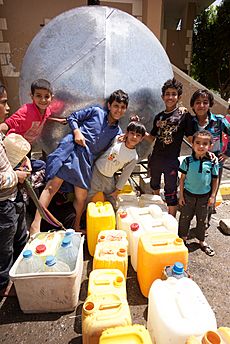
Yemen has very little water. Sanaa could be the first capital city to run out of water completely. The city gets its water from the Tawilah aquifer. This underground water source refills very slowly. In 1995, people used water from the aquifer three times faster than it refilled. Now, it's estimated to be 400–500% faster. This causes groundwater levels to drop by 6 to 8 meters (20 to 26 feet) each year. Many wells now have to be drilled very deep. Experts believe the aquifer could be empty by 2030.
About 90% of Yemen's water is used for farming. Irrigated farmland has grown a lot. Before the 1970s, traditional farming used water sustainably. Homes in Sanaa got water from shallow wells. Used water was recycled for gardens. But after deep wells were introduced, farming in Sanaa exploded. By 2010, there were about 13,500 wells. Farmers also started growing water-intensive crops like citrus, bananas, and especially qat. By 2010, about 50% of farmland in Sanaa was used for growing qat.
In Sanaa itself, the public tap water supply expanded until the late 1990s. But the city grew even faster. In 2000, only 40–50% of residents had public water. This percentage has dropped. In 2018, only 43% had public water. If residents don't have public water, they must buy water from tanker trucks, which is expensive. Tap water access is also not consistent. Even with public water, pressure can be low. Most homes get water for less than one full day per week.
There are also problems with water quality. Wastewater can get into pipes and the aquifer. A 2018 study found that the water had too many dissolved solids and bacteria. People in Sanaa often think tap water is dirty. They buy filtered water for drinking and cooking, which costs more. Private kiosks that filter groundwater are also popular.
In 2009, the average home in Sanaa used only 30 to 50 liters of water per day. This is much less than in other Middle Eastern cities.
In older times, Sanaa used an irrigation system called ghayls. These brought water into the city from outside towns. They supplied most of Sanaa's water for much of its history.
Wastewater Management
Sanaa's sewer systems are over 500 kilometers (310 miles) long. The city has two water treatment plants. The main one, in Bani al-Harith District, started in 2000. It can treat 50,500 cubic meters of water daily. The smaller one is in al-Hashishiyah. It collects wastewater from tankers. The main plant was not damaged in the conflict and is still working. But it is overloaded. The smaller plant has not worked since the conflict began.
Only 40% of Sanaa's people are connected to wastewater services (down from 45% in 2014). Over half of the population uses private cesspits for wastewater. The wastewater either soaks into the ground or is pumped out by services. Only two of Sanaa's 35 informal settlements are connected to the sewer system. In one area, sewage is dumped into an open hole.
Solid Waste Management
About 1,500 tonnes of solid waste are produced each day in the Sanaa area. The city uses the al-Azraqayn landfill. This landfill also serves the surrounding Sanaa Governorate. It has been used since the 1970s and is almost full. There is no lining at the site, so liquid waste is not collected. A facility for treating healthcare waste was planned for the landfill. It was supposed to open in March 2015. But due to the conflict, it was delayed.
Since the conflict began in 2015, the Azraqayn landfill has not worked at full capacity. Waste collection has been reduced. The waste processing building was destroyed in 2015. The landfill's scale is also damaged. In 2018, almost a third of the city's garbage trucks were damaged. Another 18% were not working. Most Sanaa neighborhoods reported poor waste management services in 2018. The city's waste collection services cover 70% of the population.
In August 2015, Sanaa employed 19 people to sort waste for recycling.
International Relations
Twin Towns and Sister Cities
Gallery
See also
 In Spanish: Saná para niños
In Spanish: Saná para niños







